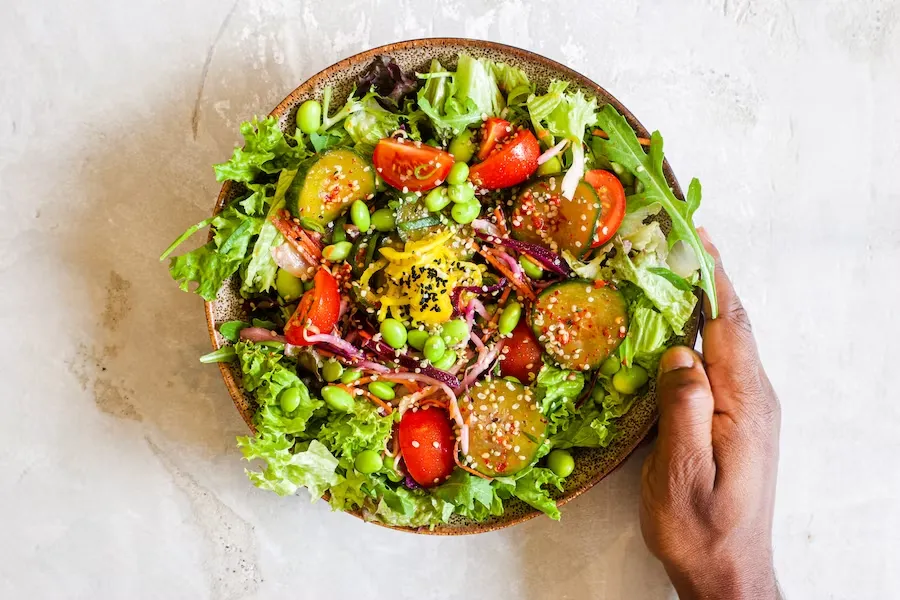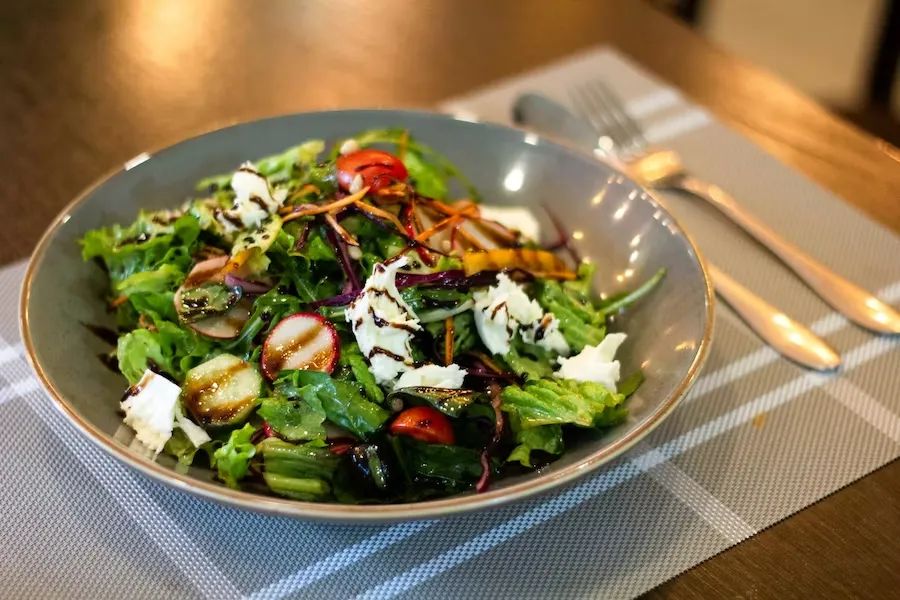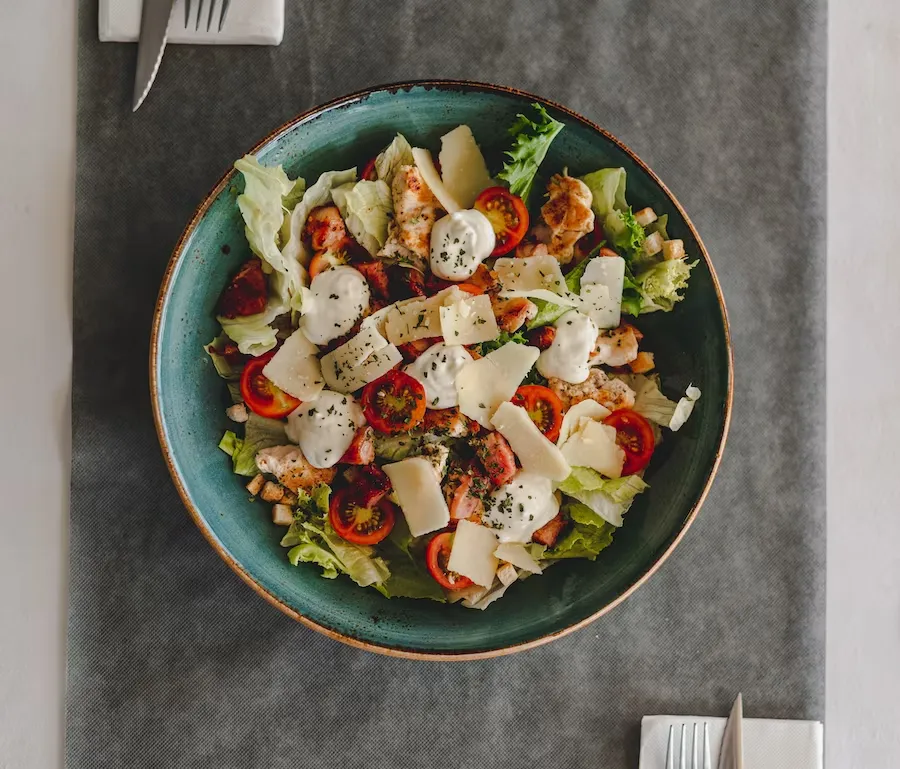1. Dakos: A Cretan Delight
Dakos, or ntakos as it’s lovingly known, is more than a dish; it’s a journey into the heart of Cretan culinary traditions. The foundation of this gastronomic adventure is a dry barley rusk called maxima. What follows is a carefully choreographed dance of flavors: crumbled mizithra cheese, chopped ripe tomatoes, whole olives, capers, fresh oregano, and a generous drizzle of the finest olive oil.
The Symphony of Ingredients
To elevate Dakos to its full potential, the choice of olives is crucial. Opt for varieties such as Koroneiki, Lianes, or Tsounates, each bringing its unique character to the ensemble. Myzithra cheese, a star player, takes center stage, shunning the common feta found in tourist-heavy locales. The barley rusk, a canvas for this masterpiece, receives a gentle rub of garlic and a sprinkle of sea salt, turning it into a flavorful foundation.
2. Mechouia Salad: Tunisian Charisma on a Plate
From the sun-kissed shores of Tunisia comes Mechouia Salad, a culinary charisma that marries the smoky essence of grilled onions, peppers, tomatoes, and garlic. Drizzled with the liquid gold of olive oil and seasoned with caraway, salt, and black pepper, Mechouia is a celebration of North African flavors. The addition of hard-boiled eggs, olives, or tuna transforms this salad into a versatile sensation.
A Feast for the Senses
Mechouia is more than a salad; it’s a feast for the senses. While it can stand proudly on its own, gracing the palate with a burst of flavors, it also lends itself to being a star on toasted bread or baguette slices. Found in the tapestry of traditional Tunisian restaurants, Mechouia is a testament to the rich culinary heritage of the region.

3. Greek Salad: Horiatiki’s Timeless Appeal
Step into the rustic charm of Greece with the iconic Greek salad, affectionately known as horiatiki. This national dish is a mosaic of quartered tomatoes, sliced red onions, and chunky cucumber slices. Depending on the region, it may feature olives, green peppers, feta cheese, oregano, salt, pepper, or a dressing made from olive oil and either lemon or vinegar.
A Glimpse into History
The name “horiatiki” whispers tales of a bygone era when farmers took simple ingredients to the fields. When feta graces the salad, it’s not just a topping; it’s a textured revelation, sliced or delicately crumbled. The Greek salad is a journey through time, a culinary bridge connecting the past with the present.
4. Fattoush: Levantine Flavors in Every Bite
Journeying to the Levantine region, Fattoush emerges as a culinary tapestry woven with traditional pita bread. The bread, transformed through toasting, grilling, or frying, intertwines with a variety of vegetables: lettuce, radish, cucumbers, cherry tomatoes, or regular tomatoes, peppers, onions, and the occasional garlic. A generous amount of herbs, particularly mint and parsley, weaves freshness into the mix.
The Symphony of Levantine Flavors
Fattoush reaches its crescendo with the dressing, a harmonious blend of olive oil, lemon juice, and pomegranate syrup. Yet, the secret ingredient lies in the subtle inclusion of sumac, a spice that lends its citrusy zing to the Levantine culinary landscape.
5. Shopska Salata: Bulgaria’s Cold Culinary Symphony
Embarking on a journey to Bulgaria, we encounter Šopska salata, a cold salad that stands as one of the nation’s culinary treasures. This vibrant dish, often gracing tables during the warm summer months, is a mosaic of chopped tomatoes, cucumbers, onions, roasted or raw peppers, and Bulgarian cheese.
A Culinary Legacy
Born in the creative kitchens of Bulgaria in the 1950s, Šopska salata was a response to the call for dishes that would entice and captivate tourists. The vegetables, carefully salted, are adorned with sunflower oil, and the pièce de résistance—a generous sprinkle of grated Bulgarian sirene cheese.

6. Ovcharska Salata: A Variation with a Twist
A playful variation of the famous Shopska salata, Ovcharska salata introduces mushrooms, eggs, and ham to the classic mix of cucumbers, tomatoes, onions, peppers, and cheese. Tossed with vegetable oil, this refreshing summer salad offers a delightful twist, a symphony of flavors that dance on the palate.
7. Houria: Tunisian Carrot Elegance
Houria, another jewel from Tunisia, unfolds as a salad crafted with simplicity and elegance. Boiled carrots form the base, transformed into a purée and combined with harissa, garlic, vinegar, olive oil, caraway seeds, and salt. The result is a colorful and flavorful salad, often garnished with finely chopped parsley.
Versatility in a Dish
The beauty of Houria lies in its adaptability. While the core remains constant, variations may include hard-boiled eggs, olives, crumbled feta cheese, or coriander. It serves not just as a side dish but as a standalone delight, bringing Tunisian flavors to tables around the world.
8. Caprese Salad: Naples’ Summer Symphony
Transitioning to southern Italy, we encounter the quintessential Caprese salad—a timeless classic that embodies the essence of summer. Ripe tomatoes, creamy mozzarella, and fresh basil converge in a vibrant medley of flavors. Contrary to common practice, the authentic recipe excludes balsamic or any other type of vinegar.
A Taste of Tradition
Originally crafted with the Re Umberto or Fiascone tomatoes, cherished along the Amalfi coast, and treccia di Sorrento, a braided mozzarella cheese, Caprese preserves the authenticity of Neapolitan cuisine. It’s not just a salad; it’s a symphony of summer on a plate.
9. Som Tam: Thailand’s Green Papaya Extravaganza
From the bustling markets of northeastern Thailand (Isaan) comes Som Tam, a green papaya salad bursting with flavors. Thin strips of green papaya, roasted peanuts, green beans, tomatoes, and a tangy sauce create a harmonious ensemble. The sauce, a delightful fusion of garlic, chili peppers, fish sauce, dried shrimp, palm sugar, and lime or tamarind juice, offers a balance of sweetness and spiciness.
Customization as an Art
What makes Som Tam truly special is its customizable nature. Restaurants and street stalls invite patrons to tailor the salad to their preferences, allowing for adjustments in ingredients and variations in sweetness and spiciness in the sauce.

10. Larb: Laos’ Flavorful Meat Fiesta
In the heart of Laos, we discover Larb—a heavily seasoned meat salad adorned with freshly chopped herbs and toasted ground rice (khao khoya). Considered the unofficial dish of Laos, Larb finds a home both in Laos and the neighboring Isan region in Thailand.
The Endless Variations
At its core, Larb involves hand-minced meat, be it beef, pork, chicken, duck, or fish. The sour notes come from lime juice, and the umami depth from fish sauce and/or padauk, a type of fermented fish sauce. The variations and combinations of ingredients are endless, a testament to the rich culinary diversity of Southeast Asia.
conclusion
These diverse salads are not mere dishes; they are ambassadors of culture and flavor, inviting diners on a global gastronomic adventure. From the sun-drenched fields of Crete to the vibrant markets of Thailand, each salad tells a story—a story of tradition, innovation, and the universal language of food that transcends borders. So, whether you find yourself savoring the robust notes of a Cretan Dakos or indulging in the spice-laden allure of a Thai Som Tam, you’re not just enjoying a meal; you’re experiencing the rich tapestry of global culinary heritage.
Read Also:- The Worst Southeastern European Salads I’ve Tried




